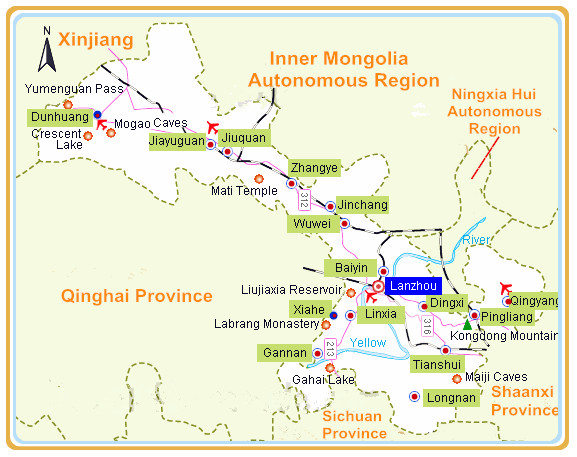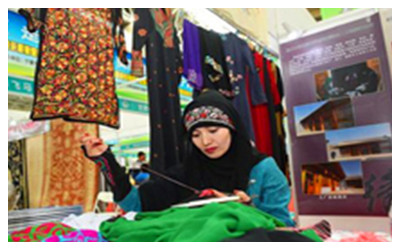
Linxia Hui Autonomous Prefecture
 Facts of Linxia
Facts of LinxiaFull Name: Linxia Hui autonomous prefecture
Population: 213,350
Area: 8,169 square kilometers
Ethnic groups: Hui, Han
Administrative Division: 5 counties (Linxia, Kangle, Yongjing, Guanghe, Hezheng); 2 autonomous counties (Dongxiang autonomous county, Jishishan Bonan, Dongxiang and Salar autonomous county); 1 county-level city (Linxia)
Seat of the Prefectural Government: No 84, Hongyuan Lu
Useful Telephone Numbers:
Tourist Complaints: 0930-6212496
Weather Forecast: 121 Zip Code Inquiry: 184
Bank of China Linxia Branch: No 57, Jiefang Lu
China Post Linxia Branch: No 8, Minzhu Dong Lu
History of Linxia
Linxia was formerly known as Han, and was later changed to Daohe and then Hezhou. Since the founding of administrative divisions during the Qin Dynasty (221BC-206BC), it has always been a link between western and central China. Linxia was a vital passage in the ancient Silk Road, Tang-Tibet and Gansu-Sichuan ancient roads, and was praised as the 'dock on land in West China'. The city was established in 1956, being one of the only two autonomous prefectures of Hui ethnic minority.
Resources of Linxia
The Linxia Hui autonomous prefecture holds six world records in terms of the quantity, species, scale and preservation of ancient animal specimens in Hezheng county unearthed in recent years. The Liujiaxia Dinosaur National Geography Park in the region has the world's largest geological relics for dinosaur footprint specimen clusters.
Tourism in Linxia
 The prefecture is also home to the nation's largest Muslim community and is one of only two Hui autonomous prefectures in China, with Islamic culture, customs, snacks and ethnic architecture frequently seen on the street. Islam, Confucianism, Taoism and Buddhism all meet in the prefecture.
The prefecture is also home to the nation's largest Muslim community and is one of only two Hui autonomous prefectures in China, with Islamic culture, customs, snacks and ethnic architecture frequently seen on the street. Islam, Confucianism, Taoism and Buddhism all meet in the prefecture.
With a history dating back to ancient times, the prefecture boosts 584 cultural relic spots and is thus a major area for the excavation of relics from the new Neolithic Age. The Majiayao Culture, famous for colored pottery relics, is representative of all the relic cultures in the region. A piece of ancient painted pottery unearthed in the Majiayao relic spot was collected by the China National Museum, confirming the prefecture’s reputation as "China's Colored Pottery Homeland".
The Bingling Temple Grotto, with a history of more than 1,600 years of history, is one of the 10 famous grottos in China. It is also among the first batch of heritage units under national protection.
The prefecture is the birthplace of Hua'er, a type of folk song popular in the western provinces of Qinghai, Gansu, Ningxia and Xinjiang. The type of song is hailed as "the spirit of West China".
The Huanghe Culture has existed in Linxia for a long time. Linxia is the birthplace of the famous legend Yu the Great Harnesses the Flood. The Yellow River flows through the prefecture for 102 kilometers with a total water volume of 33.62 billion cubic meters, thus the prefecture is a major water-supply region in the upper Yellow River region.
There are many national key projects and scenic spots in the prefecture, including the 4A Three Gorge along the Yellow River, Liujiaxia Reservoir (the largest artificial lake in Northwest China), Liujiaxia Waterpower Station (China’s first million-kW-level station and one of the first batch of national trials for industrial tourism), Bingling Stone Forest (a provincial geological park for Danxia landform), and Taiji Island (the largest artificial wetland in the upper and middle region of the Yellow River).
In addition, the prefecture enjoys abundant ecological environment and scenery, such as the 4A Songming Rock and Lotus Mountain scenic areas and Taizi Mountain natural protection zone, both of which are forestry eco-tourism attractions in the middle and southern part of Gansu province.
Economy of Linxia
The prefecture's total production value in 2011 reached 12.88 billion yuan ($2.11 billion), a year-on-year increase of 13.1 percent. This amount includes 2.7 billion yuan in production value from the primary industry, a 5.2 percent increase year-on-year. The secondary industry contributed 3.99 billion yuan in total production value, an increase of 15.3 percent year-on-year. The tertiary industry contributed 6.18 billion yuan in total production value, an increase of 15.4 percent year-on-year.
Linxia Industrial advantages
The water power and mechanical parts processing industries are centered around Yongjing county in the prefecture. Linxia is famous for Muslim food, ethnic dressings and hand-made carpets. Guanghe county has a strong leather industry and cashmere weaving industry. Linxia county is famous for brick carving and produce production and processing. Dongxiang, Hezheng, Kangle and Jishishan counties enjoy advantages in agricultural and animal products processing, building materials, and brewing industries.
The prefecture is also home to leading companies in different sectors – Hongliang Company for leather processing, Bafang Qingheyuan and Kangmei Dairy Company for Muslim food, Xuehe Company for ethnic dressing, Changsheng Iron and Steel for mechanical parts processing, Xingqiang and Xueling for hand-made carpets, Liuhua Company for fine chemistry, and Zhongtian Company for the chlorine alkali chemical industry.
Linxia Social undertakings
The prefecture has a local ethnic song and dance group, a museum, a gallery, a theater, an ethnic culture and arts research institute, eight city-level culture venues, eight public libraries, 12 museum and memorial halls, and four relics management offices. There are altogether 184 medical institutions, including 13 hospitals at the county level and above, 129 township clinics, 5,969 patient beds and 4,377 medical professionals. The prefecture launched 90 science projects, including 21 at the national and provincial level. It yielded 26 science achievements (including 10 world-class and 14 national-level achievements) and 92 patents.



 Ask Questions ?
Ask Questions ?